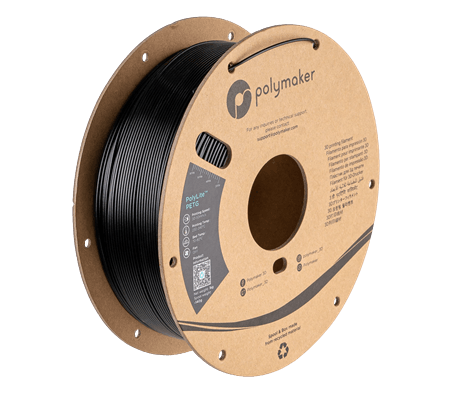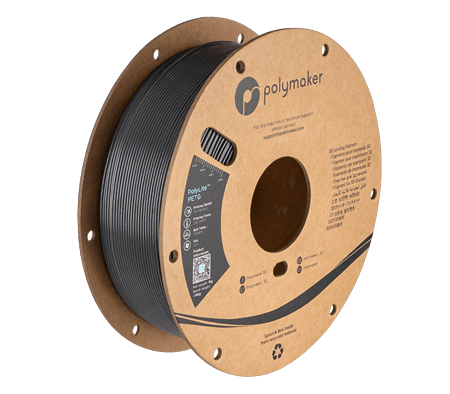-
Balanced Mechanical Properties - PolyLite™ PETG features well balanced mechanical properties; offering good strength while outperforming regular PLA in toughness.
-
Heat Resistant – PolyLite™ PETG features heat resistance up to 80°C, combined with good toughness this lends PolyLite™ PETG to more functional applications where PLA would lack the durability or heat resistance such as lighting fixtures, vibrational parts or more functional product design prototypes.
-
Easy Sanding - PolyLite™ PETG is easier to post-process than regular PLA, enabling it to be sanded to a nice smooth finish.
-
Excellent Compatibility - PolyLite™ PETG filament is compatible with a wide range of 3D printers; PETG shares many benefits of PLA such as fantastic dimensional stability with minimal warping when compared to other high temperature materials. 80°C heated bed required.
-
Uncompromised Quality - With Polymaker's industry leading quality control process and rigorous in-house testing, you can rest assured that PolyLite™ PETG will produce beautiful, reliable and accurate printed parts.
Printing Settings
| Nozzle Temperature |
230°C - 240°C |
| Build Plate Temperature |
70°C - 80°C |
| Build Surface Material |
Works well with most build surfaces i.e Glass, BuildTak® etc
Rigid build plates recommended compared to magnetic flex plates. |
| Build Surface Treatment |
Apply Magigoo Original or PVA glue to the build surface to improve adhesion. |
| Enclosure |
Not required but useful to protect from drafts and maintain a stable printing environment.
If enclosed, on some printers we will recommended to keep a door or lid open to prevent environment from getting too hot.
|
| Cooling Fan |
LOW for better surface quality
OFF for better strength |
| Printing Speed |
30 mm/s - 50 mm/s |
| Retraction |
The ideal retraction settings vary from printer to printer and depend on the hot end. The following settings have been a good starting point for many machines.
Direct Drive: Retraction distance of 1mm with retraction speed of 20mm/s
Bowden: Retraction distance of 3mm with retraction speed of 40mm/s |
| Recommended Support Material |
Single Extrusion:
Self-support.
Dual Extrusion:
PolyDissolve™ S1 (PVA) can sometimes support some models depending on its geometry.
|
The above are printing recommendations based on 0.4 mm nozzle. Please note ideal printing conditions may vary depending on your 3D printer setup. For high speed 3D printers, make sure to increase your extrusion temperature in order to use higher printing speeds.
PETG is a 'sticker' material in comparison to regular PLA. When it comes to printing PETG without stringing or blobs it's recommended to keep the filament dry and tune temperatures, retraction, speeds and flow to avoid build up of excess material on the nozzle.
For other tips printing PolyLite™ PETG contact us!
Specification
| Net Weight |
1kg |
| Material Type |
PETG |
| Density |
1.25 (g/cm3 at 21.5˚C) |
Compatibility
PolyLite™ PETG has been engineered with compatibility in mind to print excellently on a wide range of 3D printers equipped with a heated bed. PolyLite™ PETG like other materials is hygroscopic. This means that it is susceptible to absorbing moisture from the atmosphere which can subsequently affect the quality and mechanical properties of the final prints. See "Storage and Drying" details below for instructions to protect PolyLite™ PETG.
Of course with thousands of unique 3d printer models on the market, we can't guarantee each filament type will work with every 3D printer. Slicer experience and setting adjustment is always required to get the most out of a material. Before jumping into an ambitious project we always recommend printing some known calibration tests to build or make adjustments to the filament profile.
Technical Data
All testing specimens were printed under the following conditions: Nozzle Temperature = 240˚C, build plate temperature = 80˚C, infil = 100%, cooling fan = OFF
All specimens were conditioned at room temperature for 24h prior to testing.
THERMAL PROPERTIES
| |
Value |
Testing Method |
| Glass Transition |
81°C |
DSC, 10°C/min |
| Heat Deflection Temperature |
0.45MPa - 78°C
1.8 MPa - 75°C
HDT Curve
|
ISO 75 |
| Vicat Softening Temperature |
84°C |
ISO 306, GB/T 1633 |
MECHANICAL PROPERTIES
| |
Value |
Testing Method |
Youngs Modulus
(X-Y) |
2,116.8 MPa |
ISO 527, GB/T 1040 |
Tensile Strength
(X-Y) |
50.8 MPa |
ISO 527, GB/T 1040 |
| Tensile Strength (Z) |
42.8 MPa |
ISO 527, GB/T 1040 |
| Elongation at break (X-Y) |
8.4% |
ISO 527, GB/T 1040 |
| Bending Modulus (X-Y) |
1,898.5 MPa |
ISO 178, GB/T 9341 |
Bending Strength
(X-Y) |
69.6 ± 0.8 MPa |
ISO 178, GB/T 9341 |
Charpy Impact Strength
(X-Y) |
2.6 ± 0.2 kJ/m2 |
ISO 179, GB/T 1043 |
We have full MDS and technical data sheets for PolyLite™ PETG and all other Polymaker products. Contact us to enquire!
The typical values presented in Polymakers data sheet are intended for reference and comparison purposes only. Due to the nature of 3D printing they should not be used for design specifications or quality control purposes.
STORAGE & DRYING
All plastics are hygroscopic meaning they absorb moisture from the air which can affect printing quality and strength of printed parts. How quickly this absorption occurs depends on the material and your environment. Polymakers PolyLite™ PETG filaments are dried and packaged in a vacuum sealed bag with desiccant to ensure the best printing quality. When not in use PolyLite™ PETG should be stored away from sunlight and sealed in the packaged resealable bag.
Although filaments can be dried, drying will speed up the aging process of the plastic making it more brittle over time. Preventing the filament from absorbing moisture in the first place is the best solution to keep your filament working to its maximum potential. For long term storage we highly recommend storing in a sealed container with dry desiccant that reduces the relative humidity to 10-20% RH.
In-house we manage our filaments with Polymakers PolyDryer™ which keep offers best-in-class sealing to protect filaments from absorbing moisture
If you hear popping sounds and notice that the surface quality of your print is uneven or the colour is not consistent, this is a likely indicator that the filament has absorbed too much moisture. Spools of PolyLite™ PETG can be dried with Polymaker PolyDryer™ using power level 2. Alternatively if you have a convection oven that is accurate at low temperatures, users can dry filament in a preheated convection oven at 65˚C for up to 6 hours. Results may vary depending on the accuracy of your oven so please be conservative. For more information about filament drying please read our user guide.
FAQ
Q: Does PETG print exactly the same as PLA?
A: Most filament types are compared to PLA or ABS when discussing how they print. PETG doesn't print exactly like PLA but it shares closer printing characteristics to PLA than it does with ABS, especially when discussing warping. Ultimately how easy a material is to print will wildly rely on a users hardware and previous experience. We typically find that the PETG is a finicky material when it comes to tuning settings for surface quality. but most users find transitioning from PLA to PETG easier than transitioning from PLA to ABS when it comes to printing large parts. The key differences between PLA and PETG are a heated bed is very important when printing PETG, optimal printing temperatures are different and the enclosures can be more beneficial when printing some geometries.
Q: Can PETG be printed at large scales without warping?
A: In terms of dimensional stability, PETG is easier to print than high temperature materials like ABS. When using a desktop 3D printer, many large prints that would warp or crack in ABS can often times be printed in PETG without these hassles. Typically PETG can be printed at large scales without requiring an enclosure but this can vary depending on the first layer adhesion, infil and heated bed. For 3D printers that don’t evenly heat the entire bed surface an enclosure can be very helpful. Enclosures can also help to prevent drafts.
Q: Is PETG a suitable replacement for ABS?
A: Many users refer to PETG as an excellent replacement for ABS which is certainly true for some applications. When comparing regular PETG and regular ABS; ABS is still the tougher, stiffer and more heat resistant filament however many end users find PETG easier to print without warping. If users won't benefit from the added performance ABS offers, the improved printability of PETG can make PolyLite™ PETG a suitable candidate.
Q: Should I rewind this filament if I want to use it with a different spool?
A: We strongly advise against tampering with the product by rewinding. See our article for full details about the risks. All Polymaker filaments are wound with tension but without strain. Rewinding completely rearranges the curvature of the winding and this strain over time can cause most plastics to catastrophically break. If for some reason your printer is locked into fitting less than standard sized spools, there may be safe printable adaptors or external mounting solutions available.
Don't know where to start? Or which filament will suit your application? We have a broad range of support options including telephone support. Contact us today!
|
Filament |
| Diameter |
1.75mm |
| Spool Weight |
1kg |























